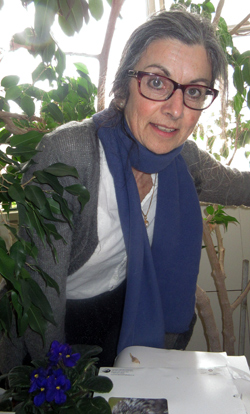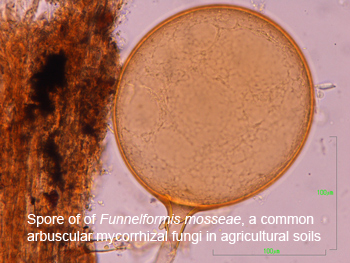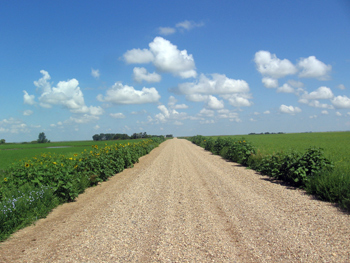The People Behind the Research
A Conversation with Dr. Chantal Hamel
Agriculture and Agri-Food Canada Semiarid Prairie Agricultural Research Centre
Activity A.9: Applying ecology for simple, nutrient use efficient pulse-based cropping systems: Phosphorus sources for organic growers of the Prairie, and agronomic strategies for effective soil microbiology to make better use of these P sources
 |
Industry Partners:
|
Collaborating Researchers:
|
Can you tell us a bit about yourself?
I come from Québec City, and studied at McGill University. I then worked for the Ministère de l'Agriculture, des Pêcheries et de l'Alimentation du Québec, where I had a chance to work with agrologists, and this is where I started to become very interested in agriculture, particularly applied work in agriculture. From there, I moved on to a few different places, settling in the Prairies in 2003. I now work for Agriculture and Agri-Food Canada in Swift Current, Saskatchewan. I love the Prairies, particularly the native prairie, and the beautiful landscape that we have, the big sky.
Can you briefly explain your Research Activity in Organic Science Cluster II?
It started with the first Organic Science Cluster, where we found that phosphorus levels in the soil on organic farms were low, potentially limiting yield. We sampled in good years, years with sufficient water, so we knew that something else was limiting yields. Phosphorus is difficult for Prairie organic farmers to add to their systems – the inputs that are allowed are expensive, and few people have access to manure. Everyone assumes that, since organic agriculture is based on using the natural resources of the soil to feed the crop, organic soils function better than non-organic soils. Maybe, even if the level of phosphorus is low, the soil could be adequate to support the production of a crop. So, I wanted to look into this more.
I started with looking at potential phosphorus sources for Prairie organic growers. I had an idea that growers could use the excess manure that is produced elsewhere. Yet, manure is full of water and so is heavy to ship. I looked at dehydrated manures, but the technology is new and the distance to ship was still far. We have feedlots in the Prairies, so I thought that maybe we can use this source, and test whether we see a response to manure application. So, we are going to test composted manure, as it is allowed in organic production, and we are also going to test rock phosphate.
 There have been tests done with rock phosphate, but they were done a long time ago, and since then, new products have come onto the market. The product that we will be testing also contains sulfur and humic acid. Humic acid is a form of organic matter, and sulfur acidifies the soil environment naturally, through the actions of microorganisms that transform the sulfur, and this may liberate phosphorus that is otherwise insoluble in the soil. There is also a mycorrhizal fungi inoculum that has been available on the market in the Prairies since around 2010, and we have agreed to test it. The product has been tested by the company that produces it, yet few independent studies have been done, so there is room for further testing, especially when used with other amendments.
There have been tests done with rock phosphate, but they were done a long time ago, and since then, new products have come onto the market. The product that we will be testing also contains sulfur and humic acid. Humic acid is a form of organic matter, and sulfur acidifies the soil environment naturally, through the actions of microorganisms that transform the sulfur, and this may liberate phosphorus that is otherwise insoluble in the soil. There is also a mycorrhizal fungi inoculum that has been available on the market in the Prairies since around 2010, and we have agreed to test it. The product has been tested by the company that produces it, yet few independent studies have been done, so there is room for further testing, especially when used with other amendments.
We are going to test these products in Swift Current, SK and in Beaverlodge, AB and we are also looking for five organic farms to volunteer. On-farm, we would apply the treatments in the fields, the farmer would simply seed over and then we would look at the response.
Another aspect that we would like to explore focuses on crop diversity. The AAFC research centre where I work is largely dedicated to wheat breeding. This got me thinking – as we select plants, we move towards plant stands in fields that have very narrow diversity, and this could be creating problems in how plants connect with soil microorganisms. If you have, for example, one plant at one spot in the field and there is a pathogen there that likes that plant, and all around that plant you have the same genotype (or cultivar), that pathogen will be very happy and will multiply. But, if beside that plant you instead have genotypes that the pathogen does not like as much or that resist the pathogen, then you will confine your infection. Theoretically this should work, and we will see if it actually does work in the field.
So, my second large research avenue in OSCII is to look at how soil biology responds to increasing the diversity of a crop stand by using a mixture of cultivars. Lentils are a very important crop in Saskatchewan, and there are a lot of different cultivars to choose from, many with the same maturity date and other similarities that are important for field management. We will try planting a mixture of cultivars together and see if this gives increased resistance against root pathogens. Also, because one variety can be more associated with one microorganism than another, we should have more diversity in the microbial community of the field for a healthier soil environment.
What brought you to this research, and what excites you the most about this project?
The previous work that we did. Researchers are like that, we get excited about what we are doing! So, I want to answer some questions that were raised from the previous work, and, at the same time, try to improve the production of organic growers. On the Prairies, we don’t have many by-products that we could apply to fields, largely because of the geography and scale of production. We’re looking for ways to do more with what we have, to look into using the soil resources better, rather than relying on inputs.
You were also involved in the first Organic Science Cluster. Can you briefly explain your project and its outcomes? Has your current Research Activity developed as a result of the first Organic Science Cluster?
In fact, there are a lot of things that came out of that project. We sampled lots of farms, and lots of fields in the Prairies for three years. We looked at the diversity of mycorrhizal fungi, which we had very little knowledge of before this study, and we found very interesting things.
[Editor’s note: Arbuscular mycorrhizal fungi live in symbiosis with their host plants, providing them otherwise unavailable soil nutrients, particularly phosphorus, in exchange for carbohydrates synthetized by the plant host.]
For example, one group of mycorrhizal fungi that is abundant in the Prairies is a group that is not well characterized. You see, soil fungi are difficult to work with because they do not grow well in the lab. They do not grow in pure culture, so you have to grow them on plants or on root cultures, which can be difficult. For taxonomy, or to figure out what species they are, you have to look at tiny spores that you sieve from the soil. This interesting group of fungi that we found are not well described or defined, but they are very special, as we did not know that they could exist. They live very deep in the soil, being almost the only mycorrhizal fungi that grow between 30 and 60 cm deep.
Surprisingly, we find that when these fungi are abundant, wheat yields are lower. We always thought that mycorrhizal fungi are invariably good, but this goes to show that, in nature, nothing is totally black or white. So far, we have only correlation evidence that when this group is present yields are lower, but we are not sure that it is the fungi themselves that have a negative influence on the plants. To test this, we would need to isolate the fungi and inoculate plants. We had a co-op student, who is finished now, trying to isolate the fungi on root cultures so we can experiment more, and hope to explore this more over the summer.
We also looked at the distribution of fungi in cultivated soils, native prairie and roadsides, and we found more of some fungi in certain field conditions, and other species in other situations. For instance, we found that the diversity was highest in the roadsides, which is good news because we have lots of roadsides! If we lose fungi from fields, maybe from pesticides, we can recover them from the roadsides. We also found that the native prairie and cultivated fields had about the same level of diversity, although the communities are changed. So, agriculture is not wiping out mycorrhizal fungi, but shifting the prevalence of certain types. One fungi, named Funneliformis mosseae, becomes very abundant in agricultural soil, and can actually be used as an indicator of agricultural soils.
With all of the work that we did on soil biology, we were able to catch the interest of a Biodiversity Centre in eastern Canada, where they have wonderful equipment and many smart people on staff. One of them is a specialist in the genetics of fungi, and can help us make probes to quantify and monitor important fungal species in the soil. This is good both for research and for farmers, because it would allow us to monitor mycorrhizal fungi in the soil easily, which we cannot do now. With just a soil sample, we could be able to see the diversity in the soil fungi, and could tailor management. For example, if we find the soil has lots of those bad fungi, we could inoculate or manage our fields differently to include plants that do not like mycorrhizal fungi. We are developing probes for mycorrhizal fungi, and also for the most important root pathogens of lentil, pea, canola and wheat. Root diseases are very difficult to look at and not many people are examining them, so this is very interesting, especially for peas. We hope to continue this work and have applied for a Genome Canada project.
[Editor’s note: For more information on Dr. Hamel’s work in the first Organic Science Cluster, please visit http://www.dal.ca/faculty/agriculture/oacc/en-home/organic-science-cluster/OSC/subproject-a/activity-a2.html]
Where is your project taking place?
We will have field sites in Swift Current, Saskatchewan on the Agriculture and Agri-Food Canada farm, as well as at another site in Beaverlodge, Alberta. We will also work on-farm if we can find volunteers. We are trying to make it easy for farmers to participate, asking for one field that will have the treatment just once, and we will use five farms for the replication that we need. The growers will benefit by being able to see if treatments work on their fields.
How do you envision that your Research Activity will help organic producers in Canada?
We hope that we can do our part for the organic industry. I hope that we can start by first bringing farmers information about their yields. When you are growing a crop, you can often tell that this field is better than that field, but you cannot tell how much each field might produce. So, we would like to give them this information, particularly how much the soil could produce if there were more phosphorus. Maybe we don’t need more phosphorus, then everyone could sleep well at night! Or, maybe we will see that we can increase yields, and can give farmers a way to figure out what benefit they could get, and whether it is worth it or not. Right now, that is not at all clear. If yield is limited, it might be by something other than phosphorus, so we really need to test this in a strict design so that we can have a strong conclusion, to substantiate the relationship between yield and phosphorus that we found in the first Organic Science Cluster.
We also hope to show producers what resources available on the Prairies might be used. If we find the feedlot manure useful, maybe the feedlots will see the value of their product and even do the composting and sell it. When looking at managing diversity, if we can increase yield, plant health and soil health with increasing diversity, then this is something that farmers could really use. Maybe there are ramifications that I do not see as a scientist, but to me this would be something simple to do, to buy seeds of different cultivars and mix them. I also hope to make an online guide about arbuscular mycorrhizal fungi, to help answer the many questions that people have.
How have the organic community and your industry partners helped to shape your research?
During the first Organic Science Cluster, I visited many different farms. The people who volunteered for our study helped me a lot – if they had not let me take samples, put flags in their fields and such, I could not have done that research and might not have wanted to continue in this line of work. It was wonderful to talk to people in the field. I was in the middle of nowhere, and people would come to chat with me.
Are there graduate students, undergraduate students, or postdoctoral fellows involved in this research?
We currently have a post-doctoral fellow who is working part-time on this project. This was the first year of the project, so we are just getting started. We are lining up a full time post-doctoral fellow, who will be starting soon. Summer students are also important, I know because that is how I started out, so we will also have summer students involved.
For more information on Chantal Hamel’s work in OSCII, please visit www.dal.ca/oacc. A print-friendly version of this article is available here [PDF - 530 kB] and an abbreviated version of this article is available here.
The Organic Science Cluster II (OSCII) project described in this article is supported by the AgriInnovation Program of Agriculture and Agri-Food Canada's Growing Forward 2 (GF2) Policy Framework and industry partners. OSCII and this article are collaborative initiatives of the Organic Agriculture Centre of Canada at Dalhousie University and the Organic Federation of Canada.

